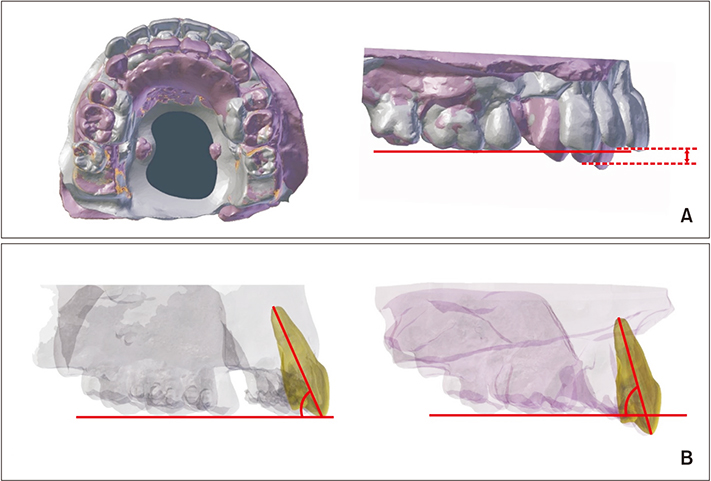Korean J Orthod.
2020 Jan;50(1):26-32. 10.4041/kjod.2020.50.1.26.
Comparison of inclination and vertical changes between single-wire and double-wire retraction techniques in lingual orthodontics
- Affiliations
-
- 1Department of Orthodontics, School of Dentistry, Kyungpook National University, Daegu, Korea. hmkyung@knu.ac.kr
- KMID: 2468638
- DOI: http://doi.org/10.4041/kjod.2020.50.1.26
Abstract
OBJECTIVE
The Heat Induction Typodont System (HITS), used in some recent studies, has a distinct advantage over previous tooth movement simulation methods. This study aimed to compare inclination and vertical changes between the single-wire and double-wire techniques during en masse retraction with different lengths of lever arms in lingual orthodontics using an upgraded version of the HITS.
METHODS
Duet lingual brackets, which have two main slots, were used in this study. Forty samples were divided into four groups according to the length of the lever arm (3-mm or 6-mm hook) and the retraction wire (single-wire or double-wire). Four millimeters of en masse retraction was performed using lingual appliances. Thereafter, 3-dimensional-scanned images of the typodont were analyzed to measure inclination and vertical changes of the anterior teeth.
RESULTS
Incisor inclination presented more changes in the single-wire groups than in the double-wire groups. However, canine inclination did not differ between these groups. Regarding vertical changes, only the lateral incisors in the single-wire groups presented significantly larger values than did those in the double-wire groups. Combining the effect of hook lengths, among the four groups, the single-wire group with the 3-mm hook had the highest value, while the double-wire group with the 6-mm hook showed the least decrease in crown inclination and extrusion.
CONCLUSIONS
The double-wire technique with an extended lever arm provided advantages over the single-wire technique with the same lever arm length in preventing torque loss and extrusion of the anterior teeth during en masse retraction in lingual orthodontics.
Figure
Reference
-
1. Lim SM, Hong RK. The Tandem Archwire technique in lingual orthodontics. J Clin Orthod. 2013; 47:232–240. quiz 267.2. Lombardo L, Scuzzo G, Arreghini A, Gorgun O, Ortan YO, Siciliani G. 3D FEM comparison of lingual and labial orthodontics in en masse retraction. Prog Orthod. 2014; 15:38.
Article3. Hong RK, Heo JM, Ha YK. Lever-arm and mini-implant system for anterior torque control during retraction in lingual orthodontic treatment. Angle Orthod. 2005; 75:129–141.4. Hong RK, Sohn HW. Update on the Fujita lingual bracket. J Clin Orthod. 1999; 33:136–142.5. Beckwith FR, Ackerman RJ Jr, Cobb CM, Tira DE. An evaluation of factors affecting duration of orthodontic treatment. Am J Orthod Dentofacial Orthop. 1999; 115:439–447.
Article6. Meikle MC. Guest editorial: what do prospective randomized clinical trials tell us about the treatment of class II malocclusions? A personal viewpoint. Eur J Orthod. 2005; 27:105–114.
Article7. Liang W, Rong Q, Lin J, Xu B. Torque control of the maxillary incisors in lingual and labial orthodontics: a 3-dimensional finite element analysis. Am J Orthod Dentofacial Orthop. 2009; 135:316–322.
Article8. Rhee JN, Chun YS, Row J. A comparison between friction and frictionless mechanics with a new typodont simulation system. Am J Orthod Dentofacial Orthop. 2001; 119:292–299.
Article9. Kyung HM, Kim JY, Kyung IK. Heat Induction Typodont System® (HITS) for simulating orthodontic tooth movement. Clin J Korean Assoc Orthod. 2013; 3:177–179.10. Kim JY, Yu WJ, Koteswaracc PNK, Kyung HM. Effects of bracket slot size during en-masse retraction of the six maxillary anterior teeth using an induction-heating typodont simulation system. Korean J Orthod. 2017; 47:158–166.
Article11. Kyung HM, Park HS, Bae SM, Sung JH, Kim IB. The lingual plain-wire system with micro-implant anchorage. J Clin Orthod. 2004; 38:388–395.12. Kim T, Bae G, Cho J. New indirect bonding method for lingual orthodontics. J Clin Orthod. 2000; 34:348–350.13. Lee JS, Park H, Kyung HM. Micro-implant anchorage for lingual treatment of a skeletal class II malocclusion. J Clin Orthod. 2001; 35:643–647.14. Isaacson RJ, Lindauer SJ, Rubenstein LK. Moments with the edgewise appliance: incisor torque control. Am J Orthod Dentofacial Orthop. 1993; 103:428–438.
Article15. Sifakakis I, Pandis N, Makou M, Eliades T, Katsaros C, Bourauel C. A comparative assessment of torque generated by lingual and conventional brackets. Eur J Orthod. 2013; 35:375–380.
Article16. Jang HJ, Roh WJ, Joo BH, Park KH, Kim SJ, Park YG. Locating the center of resistance of maxillary anterior teeth retracted by Double J Retractor with palatal miniscrews. Angle Orthod. 2010; 80:1023–1028.
Article17. Kim KH, Lee KJ, Cha JY, Park YC. Finite element analysis of effectiveness of lever arm in lingual sliding mechanics. Korean J Orthod. 2011; 41:324–336.
Article
- Full Text Links
- Actions
-
Cited
- CITED
-
- Close
- Share
- Similar articles
-
- A study of the crown inclination in normal occlusions
- Incisor inclination indicator for anterior torque control during retraction in lingual orthodontic treatment
- A photoelastic study on the initial stress distribution of the upper anterior teeth retraction using combination loop archwire and sliding mechanics
- Change in tooth length and angulation on panoramic radiographs taken at different labiolingual and buccolingual inclinations
- Torque control during lingual anterior retraction without posterior appliances




